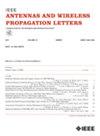衬底集成单脉冲漏角天线
IF 4.8
2区 计算机科学
Q2 ENGINEERING, ELECTRICAL & ELECTRONIC
引用次数: 0
摘要
本文介绍了一种基于基板集成波导(SIW)的单脉冲漏角天线。所提出的漏角天线由两个SIW漏波天线(LWAs)组成,以角度分离形成喇叭的喇叭口。考虑到两个LWAs的主辐射方向,通过合理设计这种角分离,可以在漏角孔径内获得平坦的波前。为了给SIW漏角提供单脉冲特性,在馈电中加入了混合耦合器和移相器。根据混合耦合器选择的输入端口,形成漏角的LWAs以相或反相方式馈送,并产生和和差辐射图。已经制作了一个原型来验证设计。在工作频带,两个输入端口的阻抗匹配低于−13.9 dB,端口之间的隔离优于16.6 dB。测量的辐射谱图显示出单脉冲特性,与模拟结果吻合较好。该漏角的深度为- 25.8 dB(和图与轴向差值之差),峰值实现增益为12.9 dBi,半功率波束宽度为6.4°。本文章由计算机程序翻译,如有差异,请以英文原文为准。
Substrate Integrated Monopulse Leaky Horn Antenna
This letter presents a leaky horn antenna based on a substrate integrated waveguide (SIW) with monopulse performance. The proposed leaky horn antenna consists of two SIW leaky-wave antennas (LWAs) angularly separated to form the horn’s flaring. By properly designing this angular separation taking into account the main radiation direction of both LWAs, a flat wavefront is achieved in the leaky horn aperture. To provide the monopulse behavior to the SIW leaky horn, a hybrid coupler, and phase shifters are included in the feeding. Depending on the input port chosen on the hybrid coupler, the LWAs forming the leaky horn are fed in phase or counter-phase and generate the sum and difference radiation patterns. A prototype has been fabricated to validate the design. In the operating band, an impedance matching below −13.9 dB is achieved at both input ports with an isolation between ports better than 16.6 dB. The measured radiation patterns show a monopulse behavior with a proper agreement with the simulated results. The proposed leaky horn presents a depth of −25.8 dB (difference between the sum diagram and the difference in the boresight axis), a peak realized gain of 12.9 dBi, and a half-power beamwidth of 6.4° at 27.5 GHz.
求助全文
通过发布文献求助,成功后即可免费获取论文全文。
去求助
来源期刊
CiteScore
8.00
自引率
9.50%
发文量
529
审稿时长
1.0 months
期刊介绍:
IEEE Antennas and Wireless Propagation Letters (AWP Letters) is devoted to the rapid electronic publication of short manuscripts in the technical areas of Antennas and Wireless Propagation. These are areas of competence for the IEEE Antennas and Propagation Society (AP-S). AWPL aims to be one of the "fastest" journals among IEEE publications. This means that for papers that are eventually accepted, it is intended that an author may expect his or her paper to appear in IEEE Xplore, on average, around two months after submission.

 求助内容:
求助内容: 应助结果提醒方式:
应助结果提醒方式:


